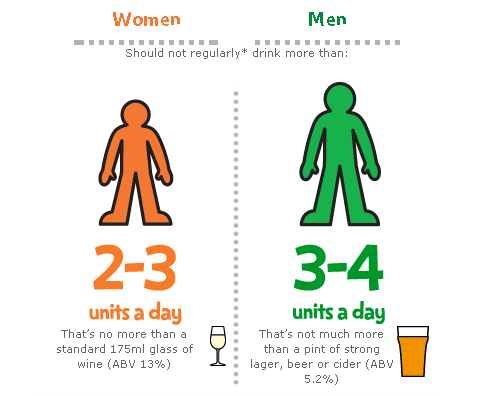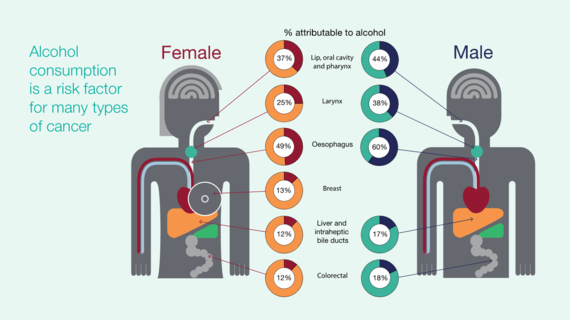It's safe to say that most people understand and accept the dangers of smoking tobacco, and we are now much more aware of the dangers of eating too much sugar. What about alcohol?
It is commonly understood that drinking alcohol heavily and regularly can lead to serious harm like liver disease and it is true that the health harms of alcohol are generally 'dose-dependent', that is the risk of harm increases with the amount drunk.
But, do you know how much alcohol you drink on a weekly basis? And does that make you a 'lower-risk drinker', an 'increasing-risk drinker' or a 'higher risk drinker'?
It's important we're all fully aware of the amount of alcohol we are drinking and what the associated risk of these levels may be because understanding your relationship with alcohol may encourage you to think twice about the amount you are drinking.
We all have an individual responsibility for our own health, and there may well be some small changes you can make to cut down on your alcohol consumption.
Labelling of alcohol products also has an important part to play in helping us to drink in moderation and be aware of how many units we're consuming.

* "Regularly" means drinking this amount most days or every day.
Your drinking may be more dangerous than you think
Around one in five of us regularly drink at levels that pose a risk to our health and this is not just from heavy drinking. Around 83% of people who regularly drink above the guidelines don't know that their drinking is risky.
Currently in the UK, a heavy or 'higher-risk drinker' is a man who regularly drinks more than 8 units of alcohol a day (about 4 pints or 2 and a half large glasses of wine) or 50 units a week.
Or, for women, it is those who are regularly drinking more than 6 units a day (3 pints or 2 large glasses of wine) or 35 units a week.
However, if you are not drinking at these higher-risk levels, you may still be drinking at levels that put you at risk. Increasing-risk drinking for a man is regularly drinking more than 3-4 units a day (around 2 pints or just over 1 large glass of wine), or for a woman, regularly drinking more than 2-3 units a day (around 1 pint or 1 large glass of wine).
By regularly drinking we mean drinking this amount most or every day.
These guidelines help people be clear about the units of alcohol they are consuming, as a way to understand and measure their level of drinking - whether it's in a can, bottle or pint glass.
The UK's Department of Health keeps these guidelines up to date in light of the latest scientific evidence, and in fact the Chief Medical Officer is currently reviewing all the guidelines on drinking.
But what are the risks to our health? As a drinker a man is about twice as likely to get cancer of the mouth, neck or throat while women are about one and a half times more likely.
There is also an increased risk of high blood pressure and women drinkers are 20% more likely to get breast cancer.
Given the availability of cheap alcohol and well-resourced and glossy marketing and advertising campaigns, it isn't surprising that alcohol is so socially acceptable and the majority of people don't fully appreciate the health risks.
Alcohol costs lives
The facts speak for themselves. Alcohol is one of the leading risk factors for ill health and early death and for men under the age of 60 it is actually the biggest risk factor for death.

There were more than one million alcohol-related hospital admissions and over 22,000 alcohol-related deaths in England in 2013/14. Because alcohol has been linked to more than 60 medical conditions, ranging from mouth, throat, stomach and breast cancers to high blood pressure and depression, the real figures could actually be much higher.
Alongside the obvious harm to the drinker, there is emerging evidence of the harm alcohol causes others, including friends and family - this includes violence and crime and the effects on mental health and wellbeing.
Alcohol costs individuals and society billions
It is easy to think that the multibillion pound healthcare cost of alcohol doesn't affect you, but when faced with illness, we all expect a fast and expert health service.
Our health system is currently under immense strain from preventable illness; from conditions such as obesity, smoking and alcohol misuse - costing us billions of pounds and posing a real threat to the NHS. Alcohol is calculated to cost the health service £3.5 billion every year - this is equal to £120 for every taxpayer.
Although obesity and smoking cost the NHS £5 billion a year each, few other health harms have such a high cost as alcohol when the impact on productivity and crime are included; alcohol stands at a staggering cost to society of at least £21 billion a year.
So, what should we do?
Health professionals provide advice on how much salt we should eat, how much we should weigh and how much exercise we should do - and it can sometimes be hard for people to keep track.
But these recommendations are based on the best evidence we have available and are there to try to help people live healthily and, ultimately, to save lives.
Many of us are familiar with counting calories, but how often do we count our units? We need to look at our own habits and the amount we drink on a daily and weekly basis and start to make small changes. This could be having a few days off drinking, having lower strength beers, smaller glasses of wine, or swapping every other drink for water.
By understanding our relationship with alcohol, being honest with ourselves about how much we really are drinking and starting to make small changes - we can greatly reduce the risks to our health and live well for longer.